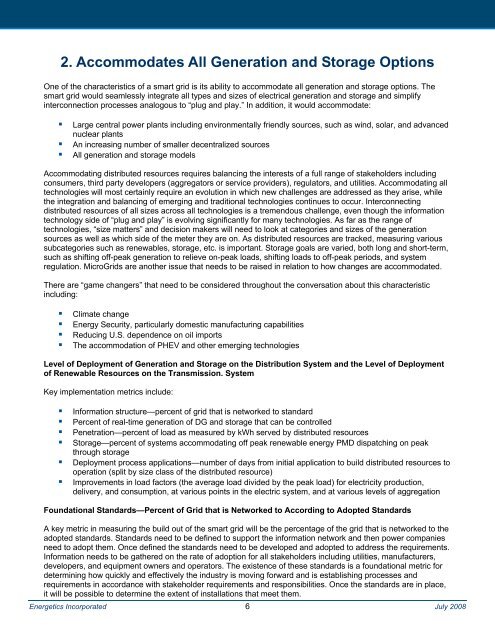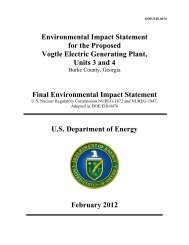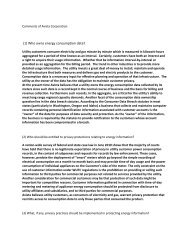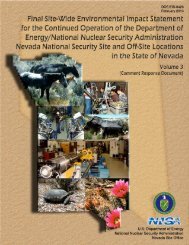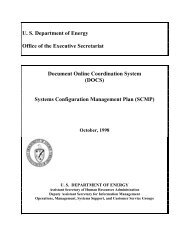Metrics for Measuring Progress Toward Implementation of the Smart ...
Metrics for Measuring Progress Toward Implementation of the Smart ...
Metrics for Measuring Progress Toward Implementation of the Smart ...
You also want an ePaper? Increase the reach of your titles
YUMPU automatically turns print PDFs into web optimized ePapers that Google loves.
2. Accommodates All Generation and Storage Options<br />
One <strong>of</strong> <strong>the</strong> characteristics <strong>of</strong> a smart grid is its ability to accommodate all generation and storage options. The<br />
smart grid would seamlessly integrate all types and sizes <strong>of</strong> electrical generation and storage and simplify<br />
interconnection processes analogous to “plug and play.” In addition, it would accommodate:<br />
• Large central power plants including environmentally friendly sources, such as wind, solar, and advanced<br />
nuclear plants<br />
• An increasing number <strong>of</strong> smaller decentralized sources<br />
• All generation and storage models<br />
Accommodating distributed resources requires balancing <strong>the</strong> interests <strong>of</strong> a full range <strong>of</strong> stakeholders including<br />
consumers, third party developers (aggregators or service providers), regulators, and utilities. Accommodating all<br />
technologies will most certainly require an evolution in which new challenges are addressed as <strong>the</strong>y arise, while<br />
<strong>the</strong> integration and balancing <strong>of</strong> emerging and traditional technologies continues to occur. Interconnecting<br />
distributed resources <strong>of</strong> all sizes across all technologies is a tremendous challenge, even though <strong>the</strong> in<strong>for</strong>mation<br />
technology side <strong>of</strong> “plug and play” is evolving significantly <strong>for</strong> many technologies. As far as <strong>the</strong> range <strong>of</strong><br />
technologies, “size matters” and decision makers will need to look at categories and sizes <strong>of</strong> <strong>the</strong> generation<br />
sources as well as which side <strong>of</strong> <strong>the</strong> meter <strong>the</strong>y are on. As distributed resources are tracked, measuring various<br />
subcategories such as renewables, storage, etc. is important. Storage goals are varied, both long and short-term,<br />
such as shifting <strong>of</strong>f-peak generation to relieve on-peak loads, shifting loads to <strong>of</strong>f-peak periods, and system<br />
regulation. MicroGrids are ano<strong>the</strong>r issue that needs to be raised in relation to how changes are accommodated.<br />
There are “game changers” that need to be considered throughout <strong>the</strong> conversation about this characteristic<br />
including:<br />
• Climate change<br />
• Energy Security, particularly domestic manufacturing capabilities<br />
• Reducing U.S. dependence on oil imports<br />
• The accommodation <strong>of</strong> PHEV and o<strong>the</strong>r emerging technologies<br />
Level <strong>of</strong> Deployment <strong>of</strong> Generation and Storage on <strong>the</strong> Distribution System and <strong>the</strong> Level <strong>of</strong> Deployment<br />
<strong>of</strong> Renewable Resources on <strong>the</strong> Transmission. System<br />
Key implementation metrics include:<br />
• In<strong>for</strong>mation structure—percent <strong>of</strong> grid that is networked to standard<br />
• Percent <strong>of</strong> real-time generation <strong>of</strong> DG and storage that can be controlled<br />
• Penetration—percent <strong>of</strong> load as measured by kWh served by distributed resources<br />
• Storage—percent <strong>of</strong> systems accommodating <strong>of</strong>f peak renewable energy PMD dispatching on peak<br />
through storage<br />
• Deployment process applications—number <strong>of</strong> days from initial application to build distributed resources to<br />
operation (split by size class <strong>of</strong> <strong>the</strong> distributed resource)<br />
• Improvements in load factors (<strong>the</strong> average load divided by <strong>the</strong> peak load) <strong>for</strong> electricity production,<br />
delivery, and consumption, at various points in <strong>the</strong> electric system, and at various levels <strong>of</strong> aggregation<br />
Foundational Standards—Percent <strong>of</strong> Grid that is Networked to According to Adopted Standards<br />
A key metric in measuring <strong>the</strong> build out <strong>of</strong> <strong>the</strong> smart grid will be <strong>the</strong> percentage <strong>of</strong> <strong>the</strong> grid that is networked to <strong>the</strong><br />
adopted standards. Standards need to be defined to support <strong>the</strong> in<strong>for</strong>mation network and <strong>the</strong>n power companies<br />
need to adopt <strong>the</strong>m. Once defined <strong>the</strong> standards need to be developed and adopted to address <strong>the</strong> requirements.<br />
In<strong>for</strong>mation needs to be ga<strong>the</strong>red on <strong>the</strong> rate <strong>of</strong> adoption <strong>for</strong> all stakeholders including utilities, manufacturers,<br />
developers, and equipment owners and operators. The existence <strong>of</strong> <strong>the</strong>se standards is a foundational metric <strong>for</strong><br />
determining how quickly and effectively <strong>the</strong> industry is moving <strong>for</strong>ward and is establishing processes and<br />
requirements in accordance with stakeholder requirements and responsibilities. Once <strong>the</strong> standards are in place,<br />
it will be possible to determine <strong>the</strong> extent <strong>of</strong> installations that meet <strong>the</strong>m.<br />
Energetics Incorporated 6 July 2008


